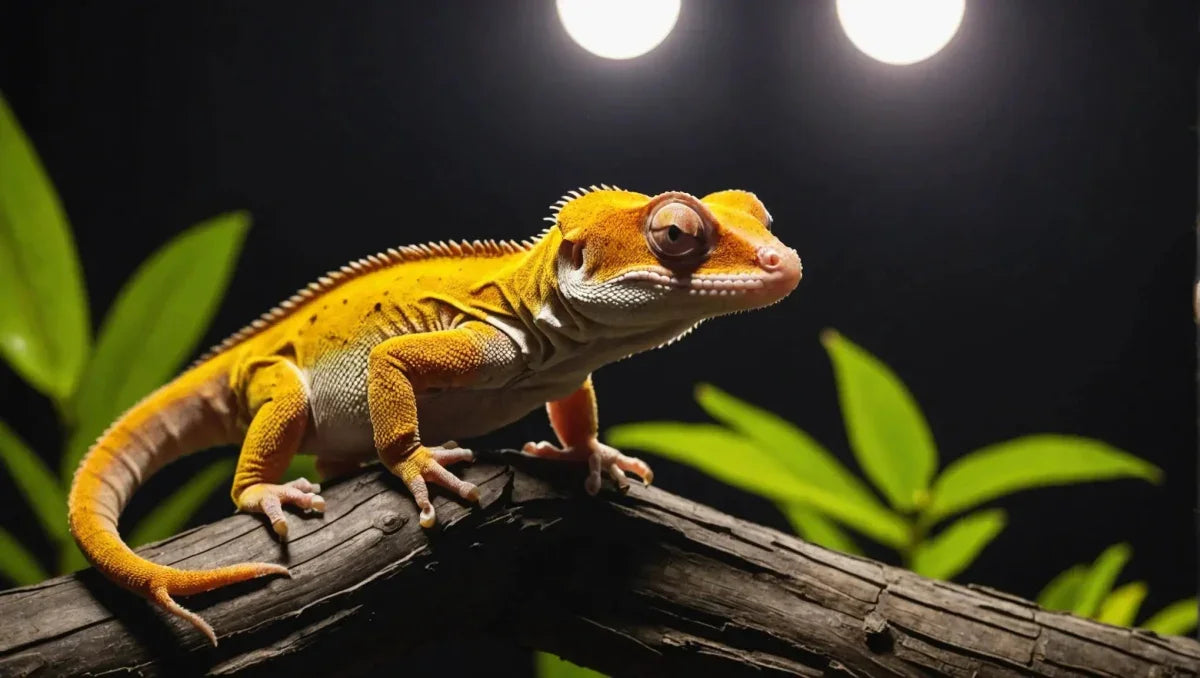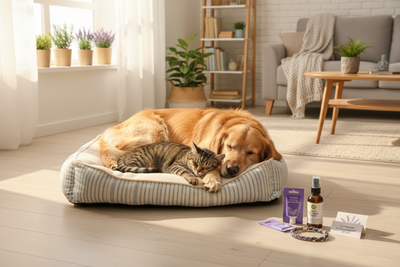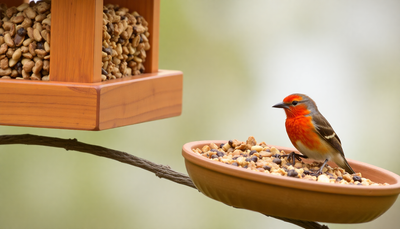Welcome to the world of Crested Gecko lighting!

In this guide, we will delve into the crucial aspect of wattage and provide you with essential tips to ensure your Crested Gecko thrives under the right lighting conditions. Understanding the proper wattage for your gecko's habitat is key to replicating their natural environment, promoting their well-being, activity levels, and overall health. From choosing the right bulbs to establishing a suitable day-night cycle, we will cover everything you need to know about lighting for your Crested Gecko. So, whether you're a new Crested Gecko owner or looking to enhance your current setup, this comprehensive guide will equip you with the knowledge to create an optimal lighting environment for your beloved pet. Let's illuminate the path to ensuring your Crested Gecko's lighting needs are met with precision and care.
Understanding Crested Gecko Lighting Needs
Natural Habitat Lighting Conditions
In the wild, Crested Geckos are primarily nocturnal creatures, so they do not require direct sunlight. However, they do benefit from a consistent lighting schedule that mimics natural day and night cycles. Providing a dim, red, or blue light during the night can help observe their nocturnal activities without disturbing their sleep.
UVB and UVA Requirements for Crested Geckos
Crested Geckos do not necessarily need UVB lighting if they are provided with a well-balanced diet that includes vitamin D3. However, exposure to low levels of UVB light can still be beneficial for their overall health. UVA lighting, on the other hand, helps in maintaining their natural behaviors and should be provided. Ensure that UVB lights are not blocked by glass or plastic as these materials filter out the beneficial UV rays.
Temperature Gradient and Basking Spots
Maintaining the right temperature gradient is crucial for the well-being of Crested Geckos. They require a temperature range of 72-80°F (22-27°C) during the day and can tolerate slightly cooler temperatures at night. Basking spots can be provided with the help of low-wattage bulbs or ceramic heat emitters. It is essential to measure temperatures using reliable thermometers placed at different locations within the terrarium to ensure the gradient is adequate.
Importance of Photoperiod
Apart from light intensity and quality, the photoperiod, or the duration of light exposure, is also significant. Crested Geckos thrive with a consistent 12-hour light and 12-hour dark cycle. This helps regulate their biological functions and maintain a healthy circadian rhythm.
Light Fixtures and Placement
When setting up lighting for Crested Geckos, opt for fixtures that emit low heat levels to prevent overheating. Position the lights so that they provide a gradient of light and shadow within the enclosure, allowing the gecko to choose its preferred level of exposure. Ensure that there are hiding spots available where the gecko can retreat if it feels overwhelmed by the light.
Understanding and providing the appropriate lighting conditions for Crested Geckos is vital for their health and well-being. By replicating their natural habitat as closely as possible, you can ensure that your pet Crested Gecko thrives in captivity.
Choosing the Right Wattage for Crested Gecko Lighting
Factors Influencing Wattage Selection
- Consider the size of the enclosure: Larger enclosures may require higher wattage bulbs to adequately light up the space.
- Temperature and humidity requirements: Crested geckos need specific temperature and humidity levels, which can be influenced by the wattage of the lighting used.
- Behavioral patterns: Understanding the gecko's behavior, such as whether they prefer basking in direct light or staying in shaded areas, can help determine the appropriate wattage.
Recommended Wattage Guidelines Based on Enclosure Size
- Small enclosures (up to 20 gallons): 15-25 watts
- Medium enclosures (20-40 gallons): 25-40 watts
- Large enclosures (40+ gallons): 40-60 watts
Types of Bulbs Suitable for Crested Geckos
- LED bulbs: Energy-efficient and emit low heat, suitable for maintaining consistent temperatures.
- UVB bulbs: Essential for providing UVB radiation needed for calcium metabolism and overall health.
- Full-spectrum bulbs: Mimic natural sunlight and help in regulating the gecko's day-night cycle.
Choosing the appropriate wattage for your Crested Gecko's lighting setup is crucial for their health and well-being. Factors such as the size of the enclosure, temperature requirements, humidity levels, and the gecko's behavior all play a significant role in determining the right wattage.
When setting up the lighting for your Crested Gecko, it's essential to create a gradient within the enclosure, providing areas of light and shade to allow the gecko to regulate its temperature effectively. This can be achieved by strategically placing light fixtures of varying wattages throughout the habitat.
In addition to wattage, the duration of light exposure is also important. Crested Geckos require a consistent day-night cycle, so ensuring they receive 10-12 hours of light per day is crucial for their biological rhythms.
By carefully considering these factors and following the recommended wattage guidelines based on enclosure size, you can create a comfortable and healthy environment for your Crested Gecko. Remember to regularly monitor the temperature and humidity levels to ensure they remain within the optimal range for your pet's well-being.
Additional Tips for Optimal Lighting:
- Use dimmer switches: If your gecko seems stressed or the enclosure temperature is too high, dimmer switches can help adjust the light intensity.
- Monitor UVB exposure: While UVB bulbs are important, too much exposure can be harmful. Be mindful of the distance between the bulb and your gecko.
- Consider a timer: To maintain a consistent day-night cycle, a timer can automate the lighting schedule, ensuring your gecko gets the required light exposure.
- Provide hiding spots: Even with proper lighting, geckos need shaded areas to retreat to when they want to rest or feel secure.
- Regularly check bulbs: Over time, bulbs lose their intensity. Replace them as needed to ensure your gecko gets adequate light and heat.
Selecting the right wattage for your Crested Gecko's lighting setup is a crucial aspect of their habitat maintenance. By considering the factors mentioned, choosing suitable bulb types, and implementing additional tips for optimal lighting, you can create a comfortable and stimulating environment that promotes your gecko's well-being and natural behaviors.
Tips for Proper Crested Gecko Lighting Setup
When it comes to setting up the lighting for your crested gecko enclosure, there are several key factors to consider to ensure your gecko thrives. Here are some essential tips to help you create the ideal lighting setup:.
- Placement of Lighting Fixtures in the Enclosure
- Ensure that the lighting fixtures are placed at an appropriate distance from the basking spots to provide the right amount of heat and light without causing overheating.
-
Use a combination of UVB and UVA bulbs to mimic natural sunlight and support your gecko's overall health.
-
Lighting Schedule and Photoperiod.
- Establish a consistent lighting schedule that simulates a natural day and night cycle for your crested gecko.
-
Aim for 10-12 hours of light during the day, followed by 10-12 hours of darkness at night to maintain your gecko's circadian rhythm.
-
Monitoring and Adjusting Lighting Conditions.
- Regularly monitor the temperature and humidity levels in the enclosure to ensure the lighting setup is providing the necessary conditions for your gecko.
-
Adjust the positioning of the lights or the photoperiod as needed based on your gecko's behavior and overall well-being.
-
Types of Lighting Fixtures.
- Consider using LED lights, which are energy-efficient and emit little heat, reducing the risk of overheating in the enclosure.
-
Ceramic heat emitters can also be used to provide supplemental heat without emitting light, ideal for maintaining nighttime temperatures.
-
Importance of UVB Lighting.
- UVB light is crucial for the synthesis of vitamin D3, essential for calcium metabolism and overall bone health in crested geckos.
-
Ensure that the UVB bulbs are replaced every 6-12 months to maintain their effectiveness.
-
Light and Plant Growth.
- If you have live plants in the enclosure, consider the light requirements of the plants when setting up the lighting to create a suitable environment for both your gecko and the plants.
- Adjust the placement and intensity of the lights to promote healthy plant growth while meeting your gecko's lighting needs.
By following these tips and paying close attention to your crested gecko's lighting needs, you can create a comfortable and healthy environment that supports their natural behaviors and promotes their overall well-being.
Common Mistakes to Avoid: How to Ensure Longevity and Efficiency in Your Lighting Setup
-
Overexposure to Light: Finding the Right Balance.
-
Using Incorrect Bulb Types: Matching Bulbs to Your Needs.
-
Neglecting Temperature Requirements: Creating the Ideal Environment.
When it comes to lighting, avoiding common mistakes is crucial to ensure the longevity and optimal performance of your lighting setup. Overexposure to light can lead to premature bulb failure and affect the overall ambiance of a space. It is essential to find the right balance between illuminating a space effectively and protecting your bulbs from excessive exposure.
Using incorrect bulb types not only impacts energy efficiency but also can cause flickering or dimming issues. When choosing bulbs, consider factors like wattage, color temperature, and the intended use of the light. Ensuring that the bulbs you select are suitable for your fixtures and lighting needs can help prevent performance issues and unnecessary energy consumption.
Neglecting temperature requirements can also be detrimental to your lighting system. Extreme temperatures can shorten the lifespan of bulbs and even pose safety hazards. It is important to place fixtures away from heat sources and ensure proper ventilation to maintain a consistent temperature around the bulbs. Additionally, using bulbs rated for specific temperature ranges can help mitigate the risks associated with temperature variations.
By being mindful of these common mistakes and taking proactive steps to address them, you can enhance the longevity and efficiency of your lighting system. Regularly inspecting your fixtures, adjusting light levels as needed, and following manufacturer guidelines for bulb selection and placement are key practices to maintain a reliable and effective lighting setup.
Remember, investing time in understanding your lighting requirements and implementing best practices can go a long way in maximizing the lifespan of your bulbs, optimizing energy usage, and creating a comfortable and well-lit environment for your space.
Importance of Proper Installation and Maintenance
Proper installation and regular maintenance are vital aspects of ensuring your lighting system's performance and longevity. Improper installation can lead to issues such as flickering lights, poor light distribution, and even safety hazards. It is essential to follow the manufacturer's guidelines and seek professional assistance if needed to ensure that your fixtures are installed correctly.
Regular maintenance, including cleaning fixtures, replacing bulbs as needed, and checking for any signs of wear or damage, is crucial for the optimal operation of your lighting setup. Dust and debris accumulation can affect light output and even pose fire risks in extreme cases. By establishing a routine maintenance schedule, you can address potential problems early and prolong the lifespan of your bulbs and fixtures.
Energy-Efficient Lighting Solutions and Upgrades
Energy-efficient lighting solutions are gaining popularity due to their cost-saving benefits and reduced environmental impact. LED and CFL bulbs are examples of energy-efficient options that offer long lifespans and significant energy savings compared to traditional incandescent bulbs.
Consider upgrading to energy-efficient alternatives to lower your energy bills and contribute to sustainability efforts. Additionally, smart lighting systems that allow for remote control and automation can further enhance energy efficiency by optimizing usage patterns and reducing unnecessary energy consumption.
Exploring these modern lighting technologies and incorporating them into your lighting setup can not only improve efficiency but also elevate the overall functionality and convenience of your space.
Conclusion
By avoiding common mistakes such as overexposure to light, using incorrect bulb types, and neglecting temperature requirements, you can ensure the longevity and efficiency of your lighting system. Proper installation, regular maintenance, and embracing energy-efficient lighting solutions are key practices to enhance the performance and sustainability of your setup.
Remember, a well-maintained and thoughtfully designed lighting system can not only brighten your space but also positively impact your energy usage and environmental footprint. By staying informed about the latest lighting technologies and best practices, you can create a well-lit environment that meets your needs while being mindful of energy conservation and sustainability.
Conclusion
Adequate lighting is essential for the health and well-being of crested geckos. By understanding the appropriate wattage and following the tips provided, crested gecko owners can create a suitable lighting environment that supports their pet's natural behaviors and promotes overall health. Remember to consult with a veterinarian or reptile specialist for personalized advice based on your gecko's specific needs.






